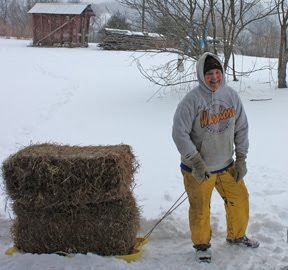This morning, the snow was beginning to look like two-day-old, 7-minute frosting on a Lord Baltimore cake, as it slumped and sagged into partially thawed dark places, soggy and forlorn. All the glitter was gone, it was beginning to seem like our permanent pathways were imminently destined to turn into mud.
And then...it started snowing. Again. So, yours truly and MM are back to hauling hay on a tiny sled. My wardrobe, as you will undoubtedly note, stays pretty conservative! My outfits don't have a lot of variety out here just off the one-lane road!
I know, I know! I still say, "I LIKE snow!" But maybe it's time for me to start whispering.
You're all probably too young to remember this, but sometimes the type of snow reminds me of when decorations for the Christmas tree were nothing like all the elaborate concoctions of today. In addition to the few and simple ornaments my mom carefully hung on the tree year after year, her final touch was the light cotton batting she used to cover the base of the tree, upon which she then sprinkled mica to remind us of the snow we hardly ever had, living on Puget Sound.
I'll bet many don't even know what mica is. Ever heard of isinglass? Again, things used to be simpler, less polluting. Clean-up after Christmas didn't mean throwing another spray can of fake snow in the trash. The mica that remained after all the presents were opened and stored, was carefully gathered up in the cotton bat and added back to its original box. Both the cotton batting and the mica would be used again and again in subsequent years. Any wayward pieces of the mica were simply swept out the door, and added back to the earth without impact other than an occasional eye-catching sparkle when spring arrived.
Today, India has the largest deposits of mica in the world. China is the top producer, followed by the USA. Mica was mined in Connecticut, New Hampshire, and Maine up into the 1960's. Isinglass is the thin, transparent sheet of mica that was used as see-through (more or less) curtains in horseless carriages. (Remember the Surrey with the Fringe on Top?..."with isinglass curtains you could roll right down in case there's a change in the weather...") To broaden your knowledge further (on a day when you're stuck inside anyway) take a keystroke stroll over to Wikipedia and learn more about mica and its uses as well as it's fascinating connection with Teotihuacan just outside Mexico City.
I do wonder, though, if the mining of mica makes mischief (translated: devastation) on the environment. Doesn't all mining do so? Hmmmmm. Food for thought...maybe we'd better just skip the fake snow altogether. And a few other things as well...
Subscribe to:
Post Comments (Atom)








Yes, please, whisper from now on. Thankyouverymuch. Heh.
ReplyDeleteHi Elora and MM:
ReplyDeleteWhat a good idea to use the mica and cotton for the xmas tree. The only experience I have with mica is with vermiculite, which is derived from mica and used in potting soils for aeration, and unlike perlite (another potting soil ingredient), absorbs water. It is also flaky and shiny.
We have a tradition here at OOHF every winter where we make a solstice tree/shrub in mid-December from natural things we find on the farm. Some years we use a four or five foot box elder tree as the structure because it has beautiful green stems on the new growth, has symmetrical opposite branching, and they’ll resprout after being cut down (they also make good hot dog roasting sticks). The naked tree goes into a large container with water and then the fun begins. We usually walk around the farm collecting anything that we think would add character to the tree. Some things we collect and hang on the tree are sycamore and sweetgum seed casings which are spiked balls about the size of a cherry tomato. We also collect bird feathers, old bird’s nests, interesting dried seed heads from a variety of trees, perennials, and grasses, pine, spruce, and hemlock cones, turtle shells, bones, etc. Finally, we’ll add popcorn and cranberries which is later used to feed the birds. It’s a lot of fun, but not for those who like a “perfect” tree with all the fancy trimmings.